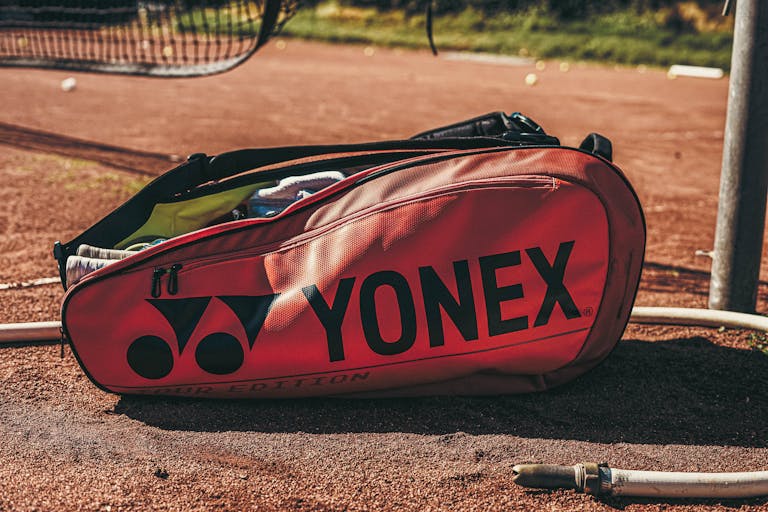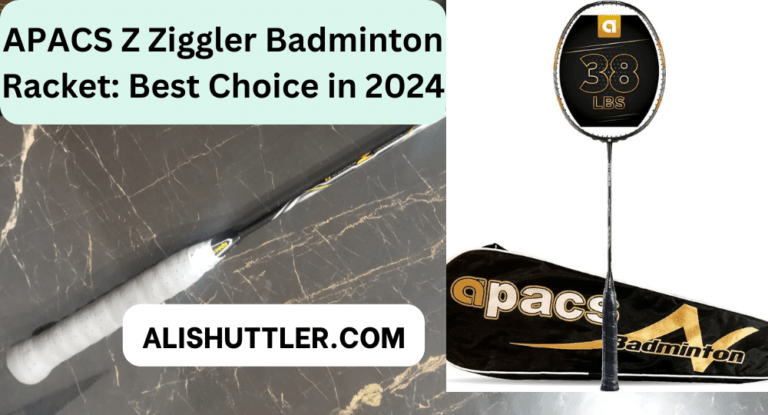Badminton shoes are designed for rapid movement and intense traction on court floors. They keep feet protected from slips, shock and strain in action.
Things such as light weight, additional sole grip and soft inner pads assist balance and lightning quick steps. All level players wear these shoes to play better and with less the chance of foot pain or injury.

Next, learn what to look for when selecting a pair for your requirements.
Essential Shoe Features
Choosing badminton shoes is crucial for those quick, cutting moves on court, as quality badminton shoes can significantly enhance your game and ensure your safety.
1. Grip & Traction
With good grip, you don’t slip when you stop, start and slide. The best shoes use herringbone or hexagon pattern on the sole for more hold on smooth, indoor court floors.
Most soles employ gum rubber for its rugged grip and gentle caress. This helps prevent unintentional slips. Other shoes employ harder rubbers for increased durability, but these can lose traction as they wear.
Grip is essential to change direction quick and move side to side under complete control. Non-marking soles are ideal for indoor courts—these don’t leave marks and keep the floor clean. Most halls do not permit marking soles, which may be present on certain outdoor shoes.
2. Cushioning & Shock
A number of brands use foam or gel pads in the heel or forefoot to absorb impact. You’ll most likely see EVA foam, PU inserts, or even air pockets in some.
As an added bonus, proper cushioning results in less muscle fatigue after extended rallies. The shock is distributed, not concentrated solely on your joints.
This assists in protecting your knees and ankles from strain or injury. To increase comfort, certain shoes provide additional cushioning around the collar and tongue.
3. Stability & Support
Sturdy heel counters prevent your foot from rolling in quick turns, reducing ankle twist hazards. Wide base soles and midfoot shanks contribute to this, providing a firm grasp as you lunge and jump.
Additional ankle support, such as built-up collars or straps, may assist those with frail ankles. Supportive insoles provide cushion for extended games.
The perfect shoe blends flex for lightning steps and sturdy sides for stability.
4. Weight & Agility
Light shoes allow you to zip around the field and pivot effortlessly. A pair under 300 grams can accelerate rallies.
Heavy shoes weigh you down and wear you out quicker. Finding the right weight means experimenting with different pairs.
Select shoes that are lightweight but still sturdy enough to shield feet. Lighter isn’t always better—you need some support for those hard landings.
5. Breathability & Comfort
Mesh uppers allow air flow so your feet don’t overheat. Other shoes blend mesh with synthetic leather for a balance of cool and durable.
Soft linings and plush padding keep feet happy through those long games. They have moisture-wicking insides that help prevent sweat from accumulating.
A good, snug fit, not too tight, so you don’t get blisters or soreness.
Player-Shoe Synergy
Choosing badminton shoes that complement your playing style is essential for elevating your game and ensuring protection on the court. The right badminton footwear not only enhances performance but also minimizes injury risk, making it a crucial aspect of your athletic gear.
Player Level
Aligning badminton shoe attributes to your player degree is crucial for performance and injury avoidance.
- For beginners, you’ll want something with simple cushioning and durable traction. Thinner soles bring your center of gravity closer to the ground, which makes you move more solidly and decreases the likelihood of injuring your ankle. A non-marking outsole will safeguard the court and provide consistent traction.
- Intermediate players might desire increased stability and additional support. Seek out shoes that provide extra arch and ankle support, allowing you to practice longer and master trickier footwork.
- Top players require top cushioning, lightweight materials and excellent shock absorption to match intense training and swift rallies. Professional-grade shoes typically range in weight from 250g to 330g. This aids quickness and reaction, crucial for blazing-fast action.
- Shoe technology advances as your skills advance. Features such as enhanced cushioning, lighter designs, and targeted support zones aid your progression and keep you performing at your peak – even on challenging match days or during grueling training sessions.
Foot Type
Each shoe’s comfort is a function of how well it fits your foot shape.
Wide feet require shoes with wider toe boxes and additional lateral support. Narrow feet fare better with snugs that prevent sliding. Players with flat feet do best with shoes that have additional arch support. This helps avoid post-game foot pain. Good fit reduces your risk of blisters, pressure points and foot slippage.
Toe box space is crucial for any foot. Ample space prevents cramping and allows toes to loosen up, particularly when making quick stops or jumps. Bad shoes cause trouble.
Select shoes that fit your foot. Perfect fit = less blisters.
Play Style
Let your playing style determine your shoe.
Aggressive net-rushing players require lightweight shoes to facilitate rapid steps, and a powerful grip to enable fast directional changes. Defensive players, who move more, might require shoes with greater cushioning and stability to absorb the impact of extended rallies and jumps.
Court movement is important. If you shuffle side-to-side a lot, shoes with more robust lateral support will shield your ankles and keep you grounded. If you’re a jumper and lander, opt for additional heel cushion to absorb the impact.
Shoes are designed differently, some with extra defensive support, others with speed-centric soles. Choosing the correct design accentuates your player strengths and complements your game style.
Player Preferences
Personal comfort always matters.
Some prefer tighter fits for control, others need more space for breathability. Shoe weight can be a big factor. Lighter shoes help with speed, but too light can mean less support.
Experiment with different brands and styles to see what works for you.
Beyond Running Shoes
Badminton is rapid with acerbic turns, stops and jumps. The footwear you select has a huge impact on your performance and safety on court. A lot of folks believe any athletic shoe will suffice, but court games such as badminton require equipment tailored for the sport.
Running shoes and badminton shoes can seem similar, but there are actual differences that are important for play and injury prevention. Running shoes are made for pound-the-pavement-forward motion, often with lots of fat, squishy cushioning. Their tread designs are contoured for streets or trails, not courts.
Badminton shoes are designed with fast, side steps, lunges and jumps in mind. Their soles are flat, fine and generally gum rubber, which grips indoor courts so much better. They provide excellent lateral support and keep your feet nice and low to the ground. They’re lighter too, so you can fly without ballast.
Below is a table that shows the main differences between badminton shoes and running shoes:
| Feature | Badminton Shoes | Running Shoes |
|---|---|---|
| Sole material | Gum rubber, non-marking | EVA, rubber, often thicker |
| Grip pattern | Fine, multi-directional for court | Linear, for straight movement |
| Cushion | Low, for stability and speed | High, for shock absorption |
| Side support | Strong, for lateral moves | Minimal, not built for sides |
| Weight | Light, for quick steps | Heavier, more padding |
| Heel-to-toe drop | Low, keeps foot flat | Higher, tilts foot forward |
Playing badminton in running shoes can increase your chances of sliding or twisting an ankle. Those chunky soles can leave you feeling clumsy and unbalanced, particularly when you have to hitch an abrupt turn. If the grip is wrong, you’ll slide on the court, resulting in falls or worse, knee and joint injuries.
Running shoes’ lack of side support allows your foot to shift and slide inside the shoe, which, over time, can lead to blisters or strains. These hazards accumulate, not only for rookies, but for anyone who hacks a lot.
It makes a difference to choose badminton-specific shoes. The grip clings to gym floors, even when the speed cranks up. Robust side support and a close fit keep your feet protected in those long rallies.

The lightweight, low-to-the-ground design allows you to respond more quickly, with less chance of spraining an ankle or straining your knees. To caring players, choosing the right shoes is an easy move with a high return.
Injury Risk Mitigation
Badminton exerts rapid strain on the feet and knees. Quick direction changes and sudden halts put injury at a real possibility, particularly as athletes age. It’s a well-established research finding that older players, above 25 years, sustain more injuries than their younger counterparts. Men, those who skip warm-ups, or those aged 26-30 are at more risk.
Choosing badminton shoes can significantly reduce these risks for all players, regardless of age or ability. Good badminton footwear helps prevent typical injuries such as ankle sprains, knee pain, or foot strain. These injuries frequently stem from abrupt side moves or landing hard after a jump.
Badminton shoes are designed with soft yet firm soles and include shock-absorbing midsoles. Quality badminton shoes provide cushioning that diffuses the shock every time your foot hits the ground, which reduces stress on tendons and joints. Support in the heel and midfoot holds the foot in place, reducing the risk of rolling an ankle.
For instance, shoes with reinforced side walls or a broader sole base provide additional traction and stability, aiding in preventing falls during badminton play. Biomechanical design makes shoes safer. That is, the contours of the shoe mimic the motion of the foot in badminton.
Elements such as non-slip soles and grip patterns assist on both wooden and synthetic courts. A study discovered that quality badminton shoes render players approximately half as likely to suffer injury than those employing non-marking shoes. Injuries occur more frequently on wooden courts, so wearing shoes with added tread and grip is essential.
Other factors are important as well. Warm-up and physical training count as much as shoe selection. Not warming up or being out of shape increases the chances of injury. How many days you play each week, how long each session lasts, and even a player’s body type (like BMI) all connect to injury rates.
Through all of these, the ideal pair of shoes can reduce the risk. For example, players who wear cushioned, well-fitted shoes and stretch prior to playing steer away from frequent foot and leg ailments.
| Shoe Feature | How It Helps Prevent Injury |
|---|---|
| Cushioning | Softens landing, lowers joint stress |
| Strong side walls | Stops ankle rolling, aids balance |
| Grippy outsole | Reduces slips on court, improves grip |
| Secure fit | Reduces foot slide, cuts blister risk |
| Shock-absorbing midsole | Spreads out impact after jumps or sprints |
| Wide sole base | Adds stability during fast moves |
Finding Your Fit
Finding your fit in badminton shoes counts for both comfort and play. A shoe that fits backs you up and gets you going on the court. The wrong fit can equal sore feet, slipping, or lost focus. Knowing what to seek out simplifies the entire experience, regardless of where you play or what your regimen looks like.
Begin by sizing your feet as near to game time as possible. Feet tend to swell a bit from standing or walking, so measuring at the end of the day provides a more true reading. Take a ruler or tape measure to your foot, recording both the length and the width in centimeters. Contrast your figures to a shoe size chart, as manufacturers vary.
Charts assist you in selecting the size that fits your foot’s form, but there’s nothing like trying on the shoes. Try shoes on with the socks you intend to play in. Other socks, thick or thin, can alter the fit of a badminton shoe on your foot. Trying them on with your game socks can help identify tight or loose areas that otherwise won’t appear.
The toe box requires special focus. There should be a little room – approximately 1/2 inch or 1 cm – between your longest toe and the front of the shoe. Others go by the thumb width method, leaving roughly a half a thumbnail’s width of room. Some utilize the ‘one finger’s width’ rule.
This little bit of space is crucial, because it prevents your toes from slamming into the front every time you stop or lunge. Not enough room, and your toes will ache after a couple of matches. Too much room and your foot can slide, causing blisters or a loss of balance.
The heel should fit snug, not tight. It should keep your heel locked so it doesn’t slide up and down while you walk. A loose heel will cause rubbing and blisters, while a shoe too tight will hurt or numb. It should embrace your foot, not strangle it.
We all have our own preferences–some like it tight, others like a little wiggle room. A perfect fit is based on your comfort, but shoes should never pinch or have excess room. That is, of course, unless you’re trying on shoes in person, which remains the best way check the fit.
Stroll, hop, and bounce side to side to feel the shoes respond. If you experience any pinch, or if your feet slide inside the shoes, test another size or style.
Sustainable Footwear
Sustainable footwear for badminton means designing shoes with lower energy input, lower raw material input, and lower waste output. Many brands are now using recycled polyester in their badminton footwear, which reduces waste and removes old plastics from landfills. Others sport vegan leather crafted with as much as 90% recycled content, reducing demand for fresh inputs and bolstering the circular economy. These decisions are significant, as the badminton shoe industry can have a massive footprint on the earth — from its raw materials to the waste it generates at a product’s end-of-life.
Sustainable brands tend to consider each step, not just the materials. They choose methods that consume less water, energy, and chemicals. Some even think beyond the shoes’ lifespan, crafting quality badminton shoes that are easy to recycle or degrade. For instance, a few designs have fewer glue varieties or stick to a handful of core materials, making it simpler to dismantle the shoes after. This type of planning reduces waste and retains more materials in circulation.
In the long run, going for sustainable badminton shoes does more than just help the earth. These shoes are typically built to last longer, with wear-resistant designs. That translates into less replacing, less waste, and ultimately spending less money over time. Durable shoes that last longer create less need for new ones and less stress on the supply chain.
Others release small collections or pilot runs of green shoes to experiment with new materials and receive feedback from buyers informing the process for all. By supporting companies that strive to reduce their environmental impact, you can help nudge the entire market to improve. A lot of buyers ask us questions like how are shoes made, what are they made of, and where do they go when they’re worn out.

This changing demand has led to more choices in badminton footwear, even with some brands providing complete breakdowns of their supply chains and carbon footprints. Opting for these firms can signify supporting better practices, such as fair labor and tidier plants, not simply more verdant stuff.
Final Thoughts
Badminton shoes provide traction, support and feather-light footing for rapid gameplay. Great shoes protect feet from both slips or sore spots. Every player moves a little differently, so choosing shoes that properly fit and support those moves makes a big difference. Running shoes don’t provide the same traction or support in the court.
Brands are even making shoes out of earth-friendly materials nowadays! Others employ recycled mesh or water-based glues. Choosing the right footwear benefits your play, makes your feet smile and can save the earth. Be sure to scan what you need, compare shoe labels, and TRY A FEW PAIRS ON! Your feet and your game will be grateful. Browse new arrivals and find your fit.
Frequently Asked Questions
What features should I look for in badminton shoes?
When choosing badminton shoes, look for options with non-marking soles, great traction, and lightweight badminton shoes that offer superior ankle support and breathability to enhance comfort during fast cuts.
Can I use running shoes for badminton?
Choosing badminton shoes is essential, as running shoes lack the lateral support and proper court grip needed for quick side-to-side movements in badminton play, increasing the risk of injury.
How do badminton shoes help reduce injury risk?
Choosing badminton shoes is essential, as they provide stiff ankle support, shock absorption, and excellent grip, preventing slips and injuries during intense badminton play.
How do I choose the right size badminton shoes?
When choosing badminton shoes, take a good measurement of your feet while wearing your normal sports socks. Ensure there’s approximately 0.5-1 cm of space in the toe box for optimal comfort and fit.
Are there sustainable options for badminton shoes?
Yup, one or two even have quality badminton shoes crafted out of recycled materials or nifty eco-friendly processes. When choosing badminton shoes, seek out certifications or eco-labels for sustainable options.
Why is player-shoe synergy important in badminton?
Choosing badminton shoes that fit your style of play and foot size is essential, as it maximizes both performance and comfort, allowing for fluid movement and reduced fatigue during matches.
How often should I replace my badminton shoes?
Swap out your shoes every 6 to 12 months, or when they show obvious signs of wear. Depleted soles and compressed foam may affect output and leave you susceptible to injuries.






